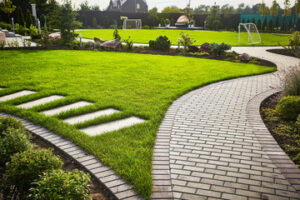A well-designed landscape can add significant value to your property. It can also improve your lifestyle by providing a relaxing environment to enjoy the outdoors.

Landscaping includes the addition of plants, changes to terrain and construction of structures. It can be done for aesthetic or practical reasons, including irrigation and erosion control. Visit https://www.primecutlawnky.com/ to learn more.
A well-manicured yard is a major selling point for homebuyers. Adding curb appeal with colorful plants and trees is an inexpensive way to increase your home’s value. Studies have shown that a house with beautiful landscaping sells for about 10% more than those without lush greenery.
Landscaping also adds value by reducing the amount of energy needed to cool and heat your home. Well-placed trees, shrubs and lawns block wind from passing through the property, and shaded areas reduce sun exposure. These strategies can result in up to 15% reduction in heating and cooling costs.
Besides raising your home’s resale value, landscaping provides many other benefits for you and your family. It increases the quality of life by providing a peaceful place for relaxation and enjoyment of nature. It also reduces stress levels and promotes health by reducing anxiety, depression and tension. Studies have also shown that spending time in nature boosts the immune system and releases endorphins, the body’s natural feel-good chemicals.
In addition, a well-designed landscape helps prevent erosion and soil compaction around your home. The addition of retaining walls, terraces and swales can help stabilize sloped yards and limit soil movement. This reduces the potential for damage to your home and lowers insurance premiums.
If you are thinking of selling your home, professional landscaping can make the process faster and easier. A well-designed and maintained yard will be appealing to prospective buyers, and they are likely to pay a higher price for your home. It is important to maintain the landscape throughout the year to ensure that it stays in top condition.
It is also important to consider the effect of the surrounding neighborhood on your home’s value when deciding what landscaping features to add. For example, if you live in a neighborhood with similarly-sized homes and well-maintained landscaping, it is unlikely that your yard will stand out from the competition. If you want to create a unique look for your property, try using focalization, which involves drawing attention to one part of the garden with a single element. This can be achieved by adding sculptures, fountains, water features or even tall plants. However, it is important to avoid abrupt changes in size, color and texture, as these can be jarring for viewers.
Adding Value to Your Property
If you’re planning to sell your home in the future, landscaping is one of the best investments you can make. It increases your home’s resale value and makes it more appealing to buyers. Studies have shown that buyers are willing to pay more for a house with well-maintained yards. Landscaping can also add value to a business by creating an appealing environment where customers and employees want to spend time.
When it comes to landscaping, there are two main components: hardscapes and softscapes. Hardscapes are the non-living parts of your landscape, including driveways, sidewalks, patios and walls. Softscapes include trees, shrubs and flowers. Lighting is another important feature that can be used to create a dramatic effect. It’s a good idea to combine different elements of your landscape to create focal points and define areas.
It’s important to choose the right plants for your climate. Plants that are native to your area tend to thrive in their environment and need less maintenance than imported exotic plants. Native plants also attract pollinators and help to sustain local biodiversity.
Landscaping can also improve a property’s energy efficiency. Trees and bushes can provide shade in the summer, which reduces air temperature and lowers utility bills. Using drought-tolerant plants is also an effective way to save water.
One of the most overlooked benefits of landscaping is its mental health benefits. Spending time in nature has been proven to decrease stress levels and depression. Proper landscaping can also create a relaxing environment where you can enjoy the outdoors with friends and family.
It’s also a great way to create privacy. You can use plants to create natural fences, which will help to block noise from nearby roads or neighbors. Additionally, plants can help to reduce erosion and increase soil stability. A well-maintained landscape can also help to reduce air pollution by removing carbon dioxide and reducing the amount of dust and smoke in the air. This is especially beneficial for people who live in urban areas. Landscaping can also improve your property’s street appeal by adding curb appeal and making it easier to navigate the neighborhood.
Adding Value to Your Life
A beautiful landscape can improve the quality of life for you and your family. It can help you relax and enjoy your backyard and garden. It can also give you a place to entertain friends and neighbors or just spend some time alone. It can even help you feel healthier by lowering stress levels and increasing focus and memory.
In addition, landscaping can save you money on maintenance costs. It can eliminate the need for mowing, fertilizing, herbicides, insecticides, soil amendments, mulch applications, and watering (once established). Instead of traditional turf grass, consider replacing it with native trees, shrubs, and perennial plants that require less maintenance. Native plant species are not only low-maintenance, but they’re also a lot more cost-effective than exotic plantings over the long term.
Landscaping also provides many aesthetic benefits, including creating focal points and defining spaces. It can use plants of varying heights, shapes, and colors to add interest and create transitions between areas. It can also include curved pathways and retaining walls to create a sense of fluidity and movement in the space.
When it comes to selling your home, the outdoor landscape can have a significant impact on its value. Potential buyers want to see a well-maintained yard and will be more likely to buy your house if it looks appealing.
The outside of your home is the first thing that people will notice. It’s important to have a well-maintained, attractive front lawn, so it will stand out from the rest of the neighborhood.
In addition, having a well-maintained landscape can increase your curb appeal, which is one of the most important factors in a home’s value.
Your landscape can be a great way to express your personal style and show off your creativity. You can use a variety of design techniques to create a unique look that’s right for you.
Whether you’re interested in improving your yard or planning on selling your home, we can help. Contact us today to learn more about how a new landscape can add value to your property!
Adding Value to Your Environment
A well-maintained landscape has many benefits for the environment and also adds value to your property. For instance, it reduces energy costs by shading your home and creating a cool atmosphere. It also prevents soil erosion and enhances wildlife habitats. In addition, trees and plants provide oxygen and absorb carbon dioxide, helping to improve air quality.
There are two main types of landscaping: hardscaping and softscaping. Hardscaping includes elements such as patios, walkways, and walls, while softscaping refers to the green elements of a landscape such as trees, shrubs, and flowers. In addition, there are many other aspects of a landscape that can be added to create the desired appearance.
The most important element of a landscape is the overall design. It should be balanced and include focal points that draw the eye. A good example of this is a water feature or a statue. It should also be framed by trees and flowers. Another important factor is the use of repetition. This can be done by lining up similar plants or by using geometrical shapes like squares. Lastly, the use of movement is important. This can be achieved by overlapping shapes or by making gradual changes in size, shape, and texture.
Moreover, a professional landscaper can help you select the best plant varieties and materials for your home. He can also teach you how to care for the plants and maintain them. In addition, he can help you find ways to save on energy costs and reduce water usage.
Landscaping also helps you to get in touch with nature and relax. Studies have shown that being surrounded by nature reduces stress and anxiety, as well as improves mental health. A beautifully designed and maintained garden is an ideal space to relax, read a book, or just spend some time with family and friends.
In addition, a landscape can increase your property’s value when it is time to sell. Research has shown that buyers are willing to pay more for a home with well-maintained landscaping. In addition, a well-designed landscape will attract more potential buyers and shorten the time your home is on the market.



